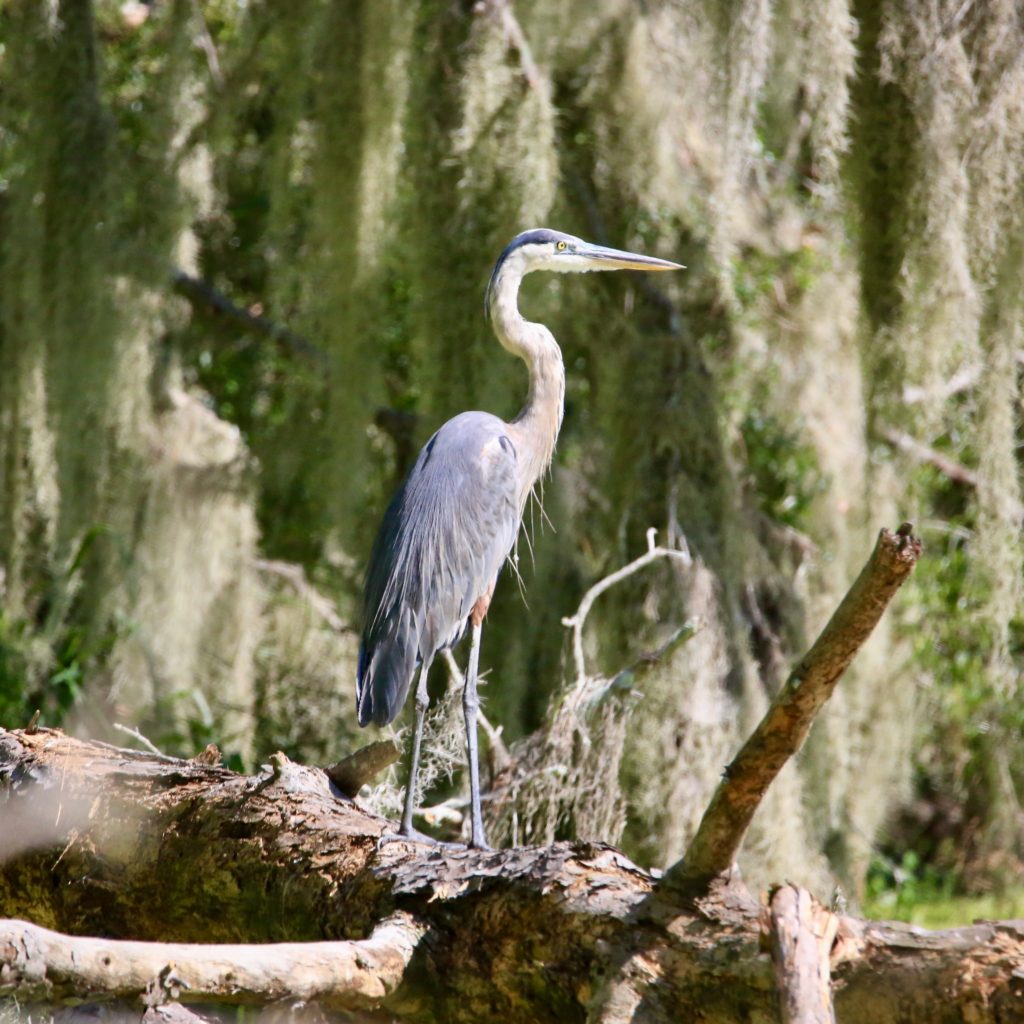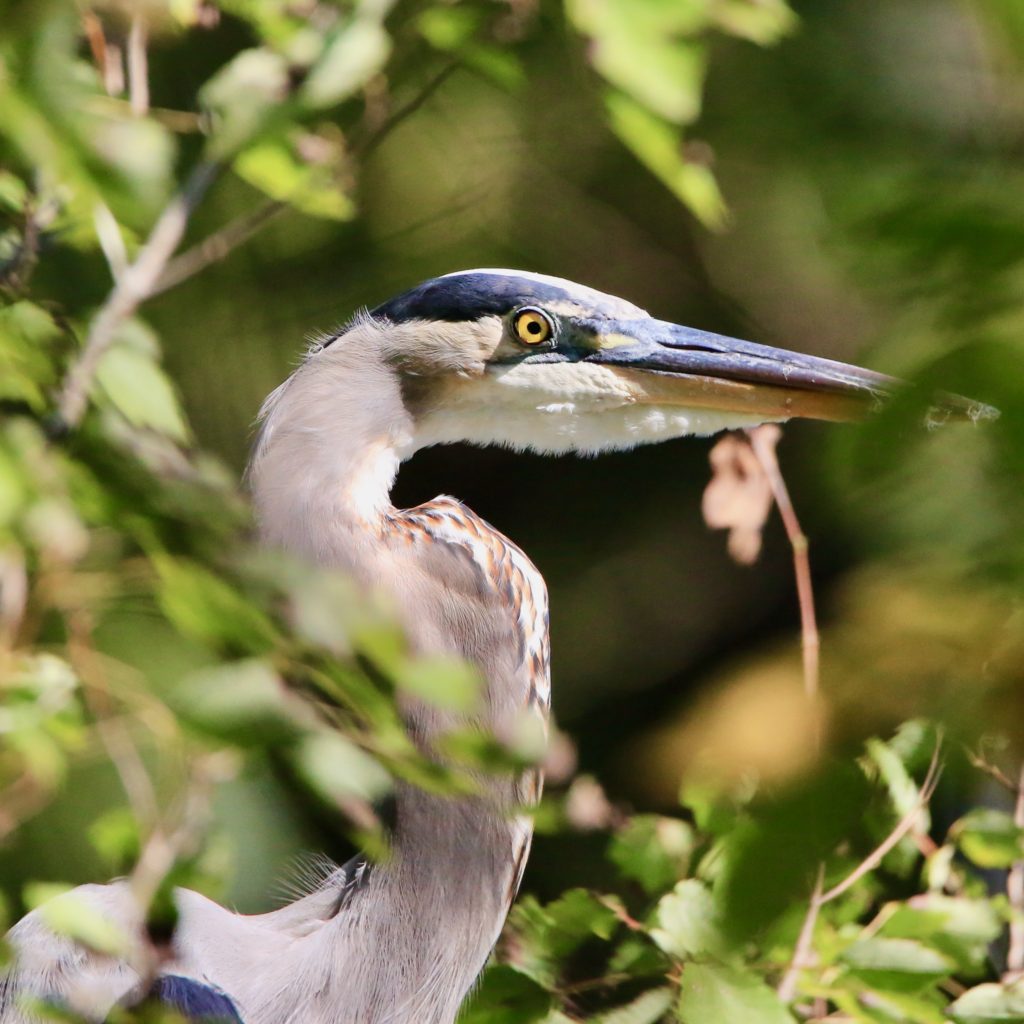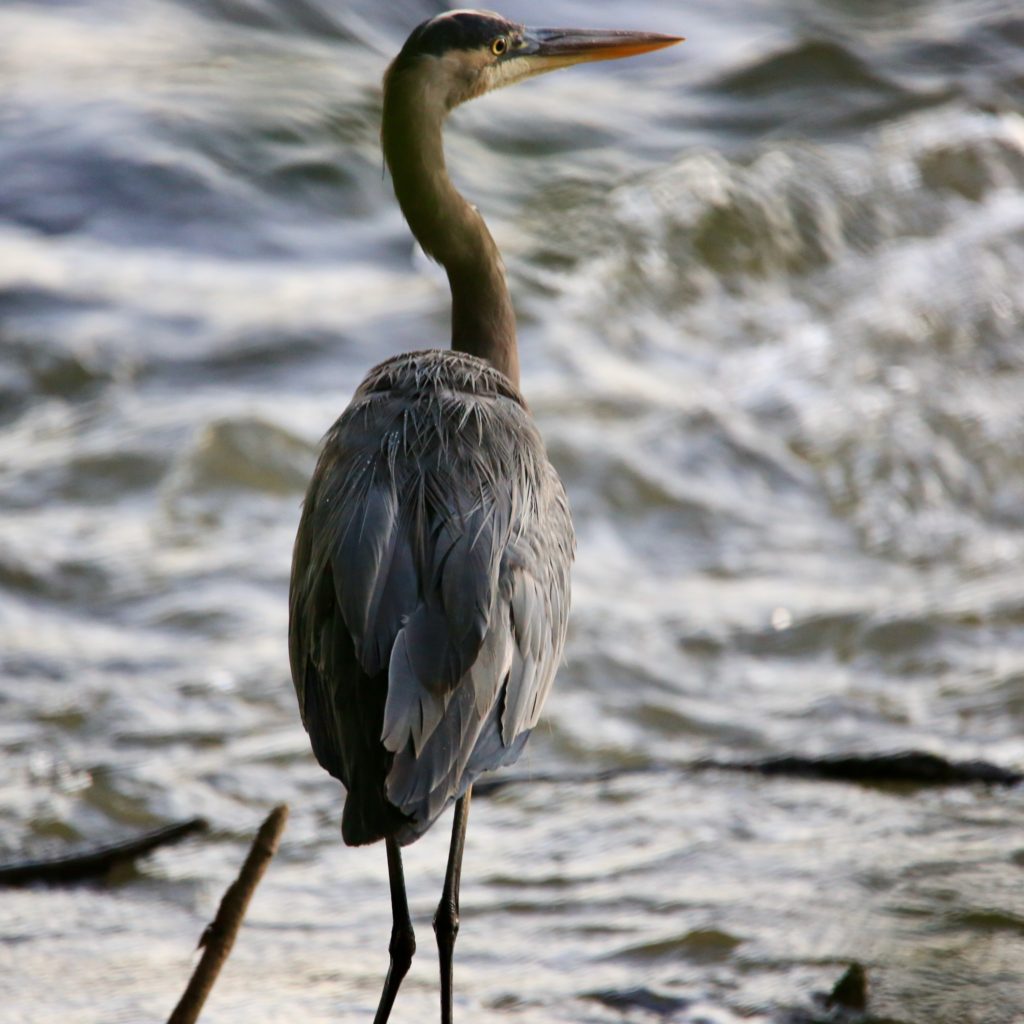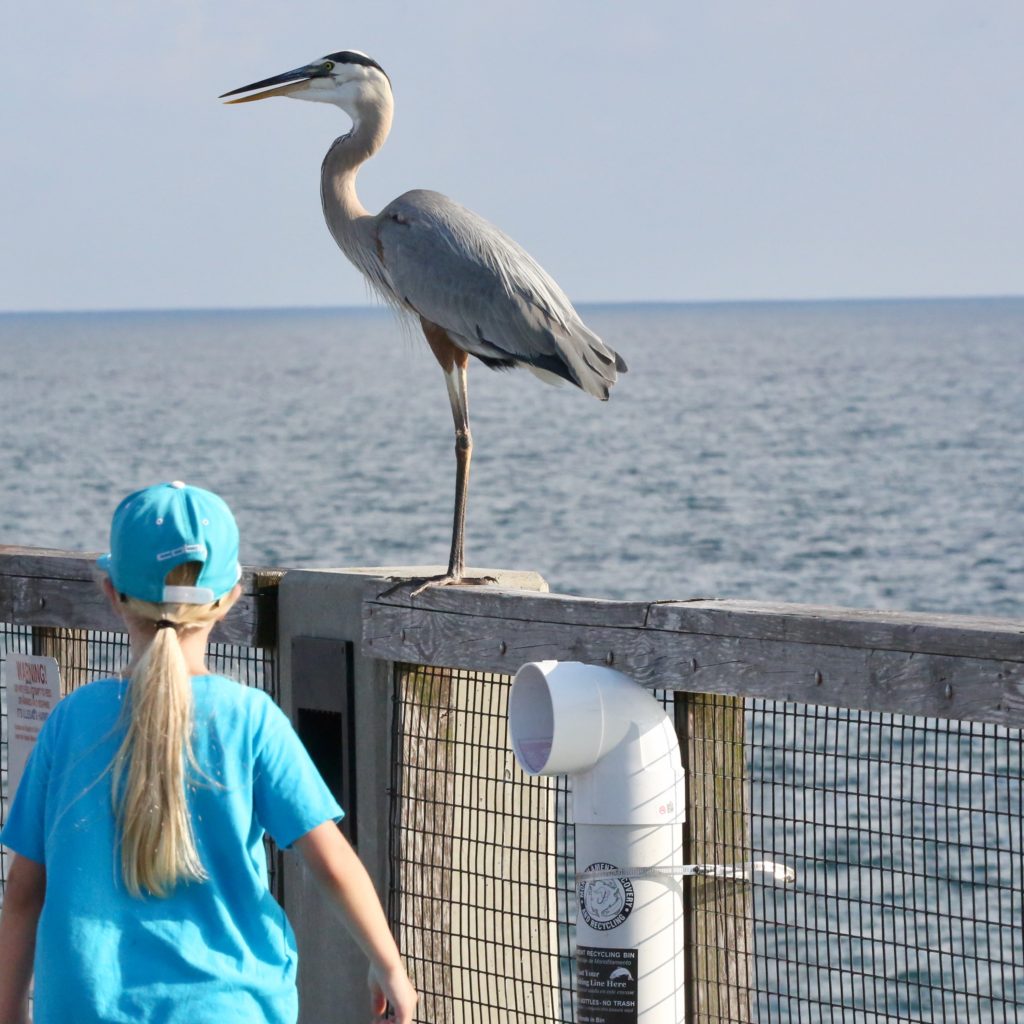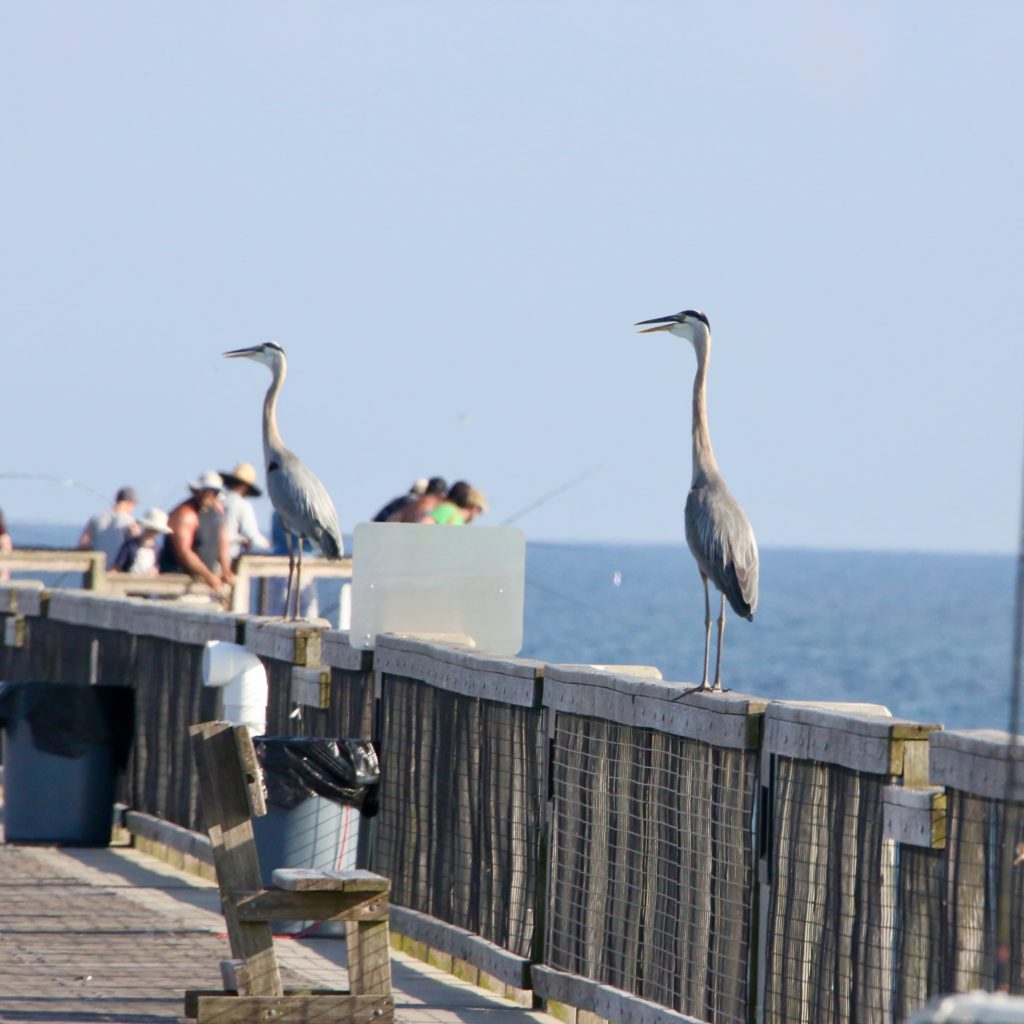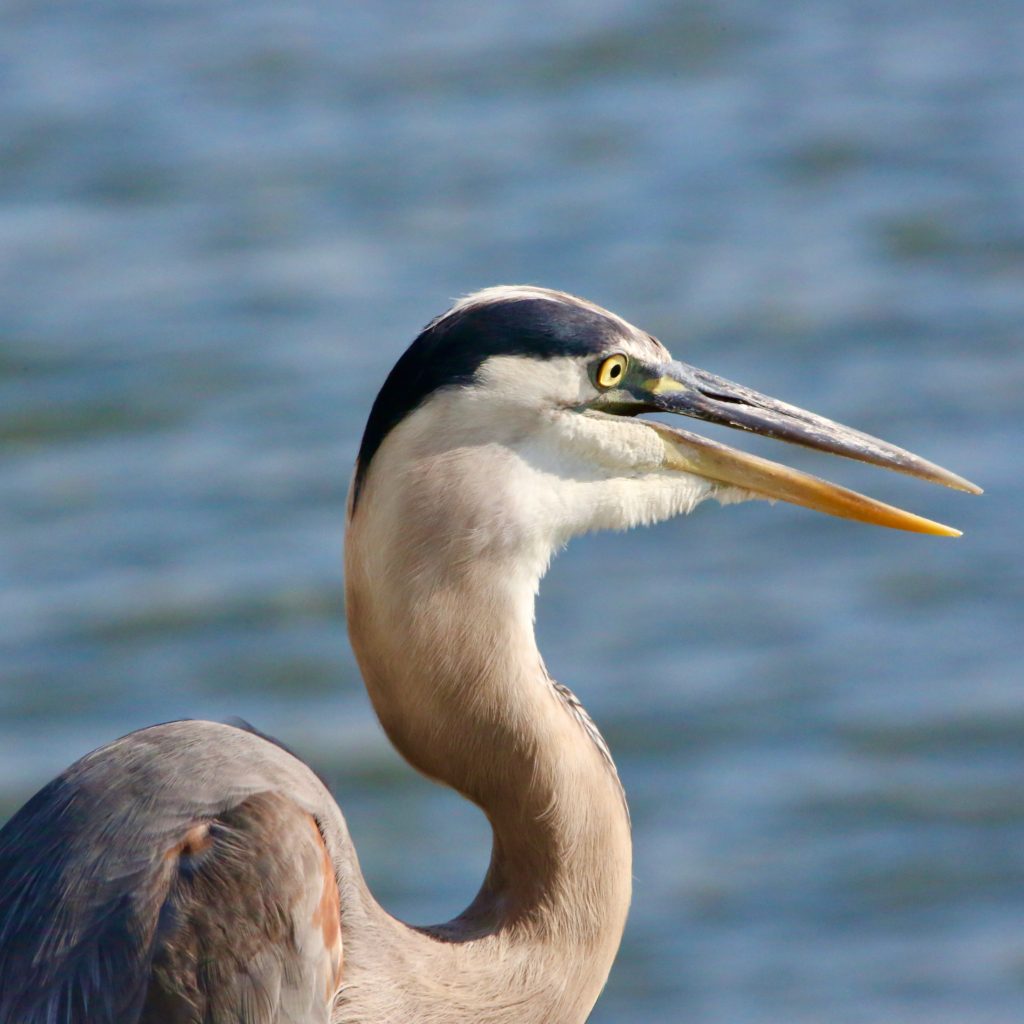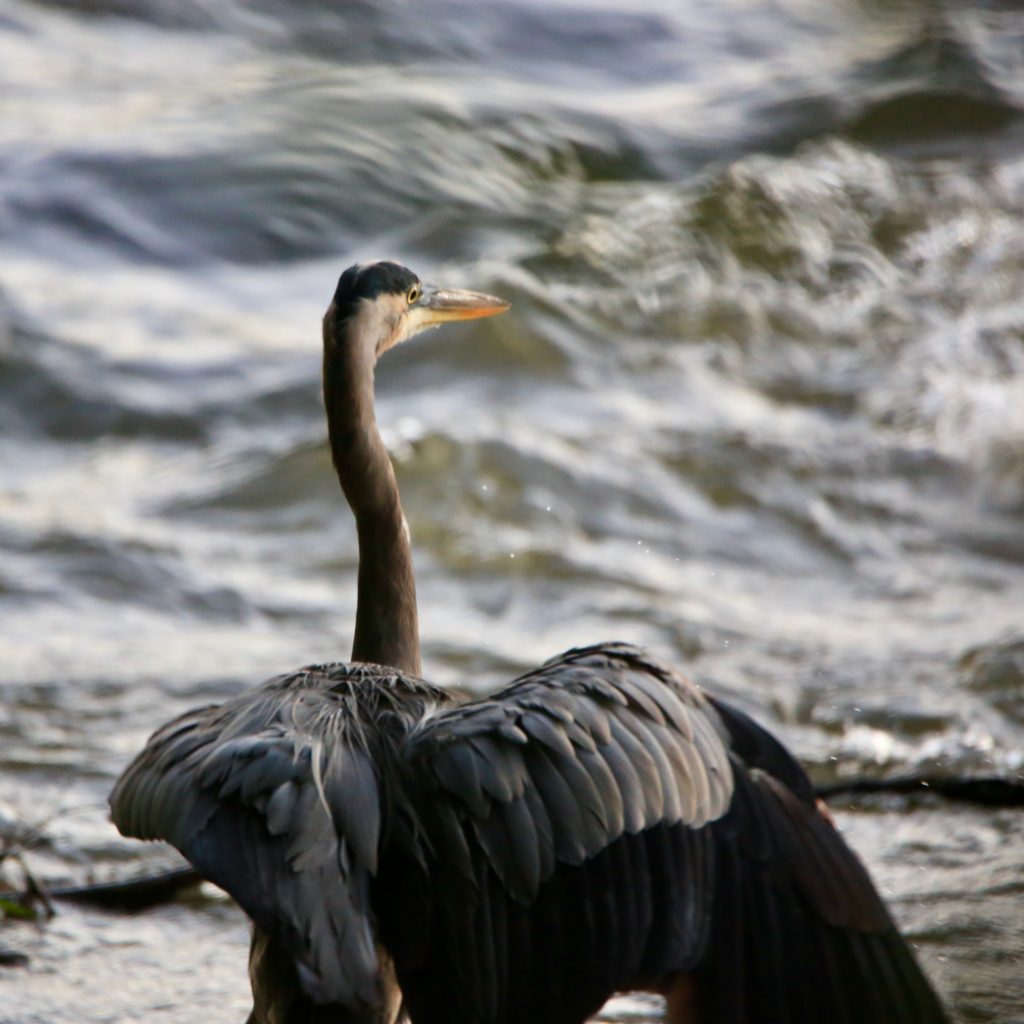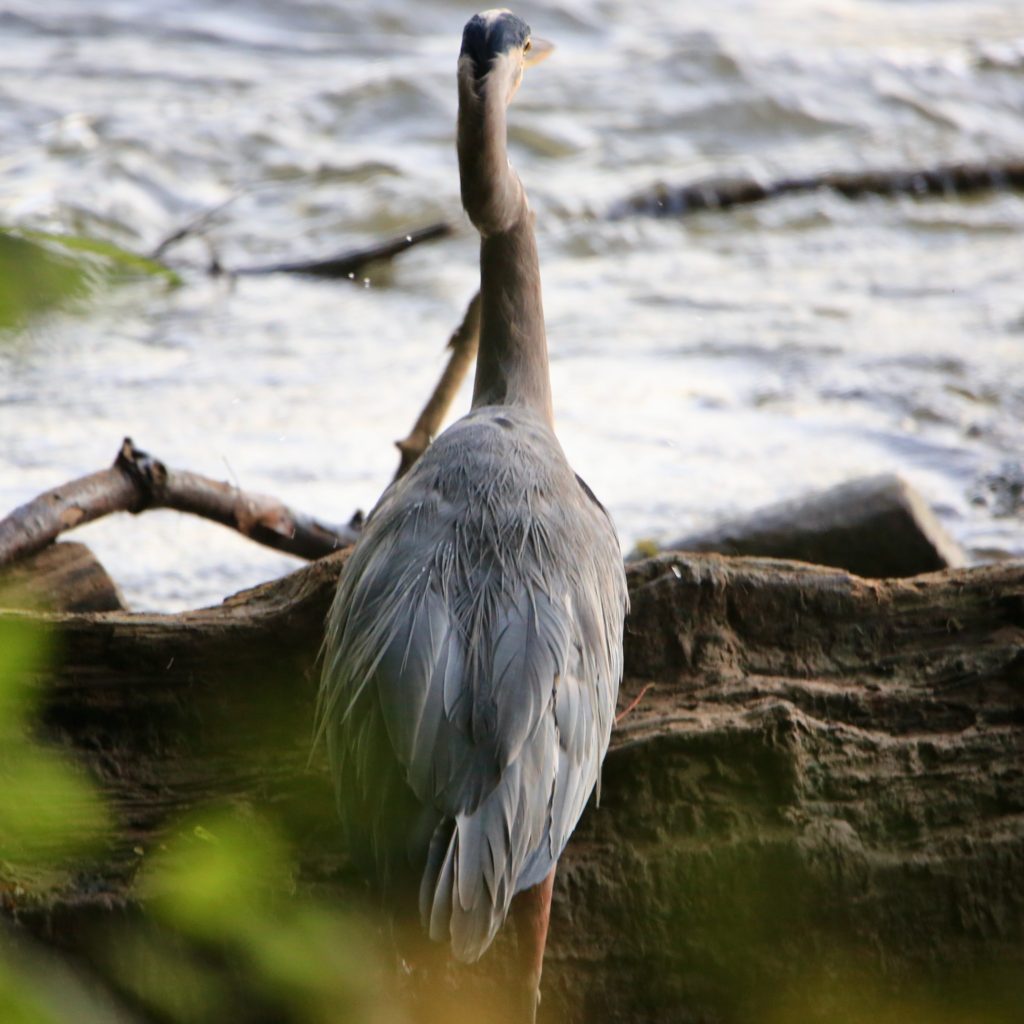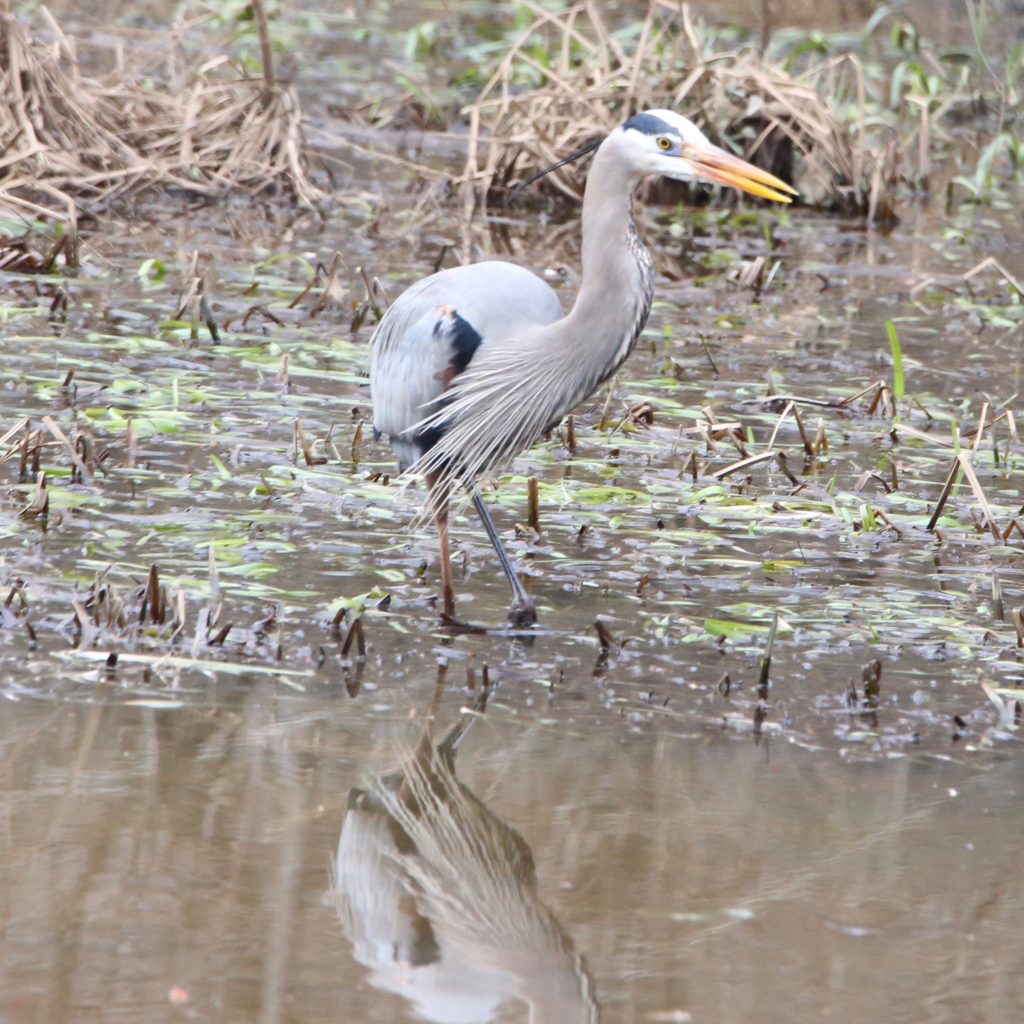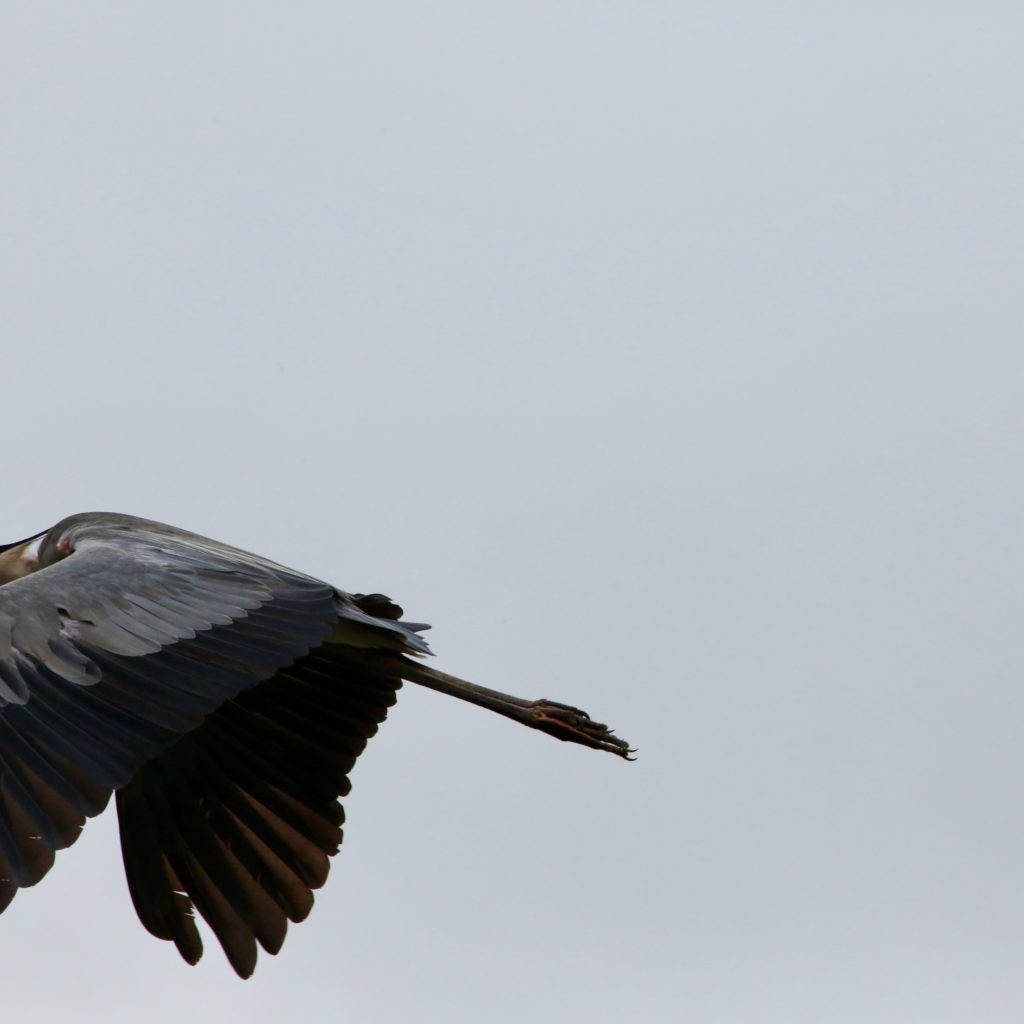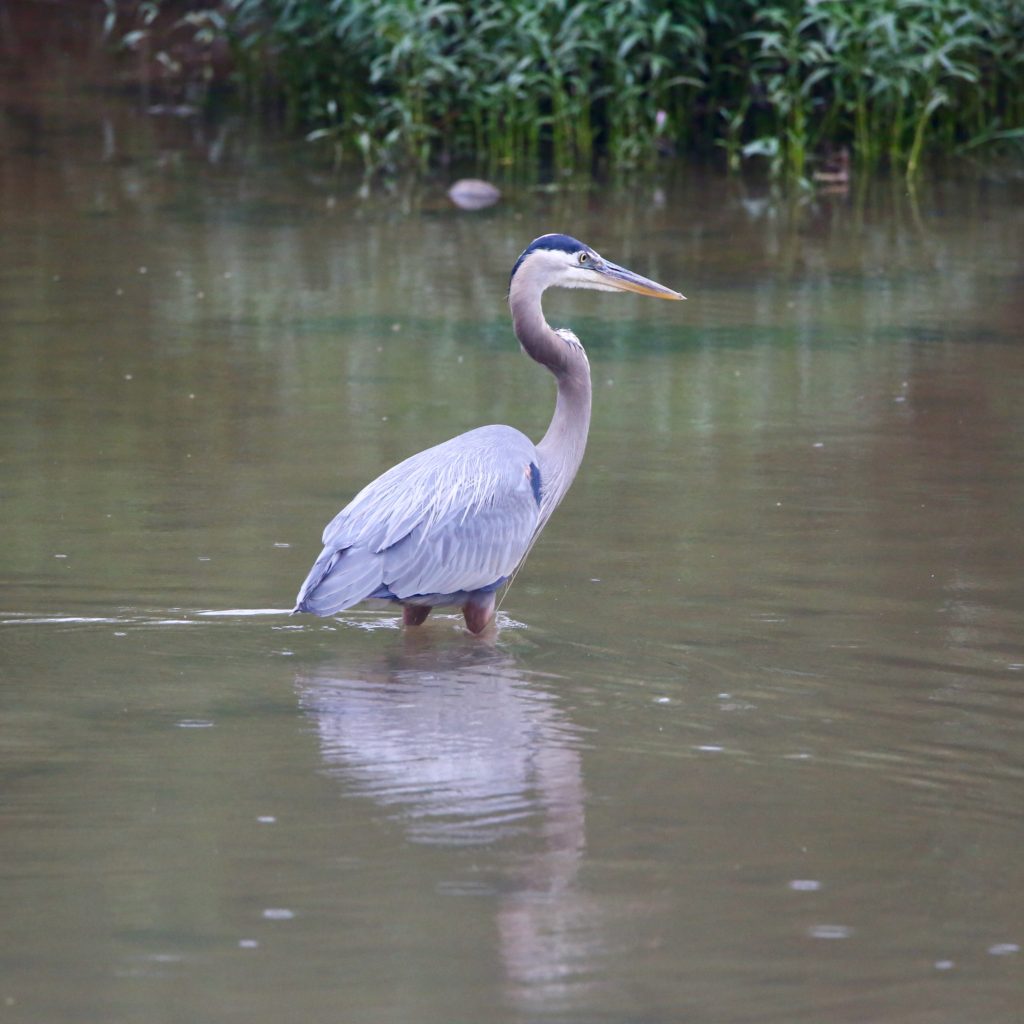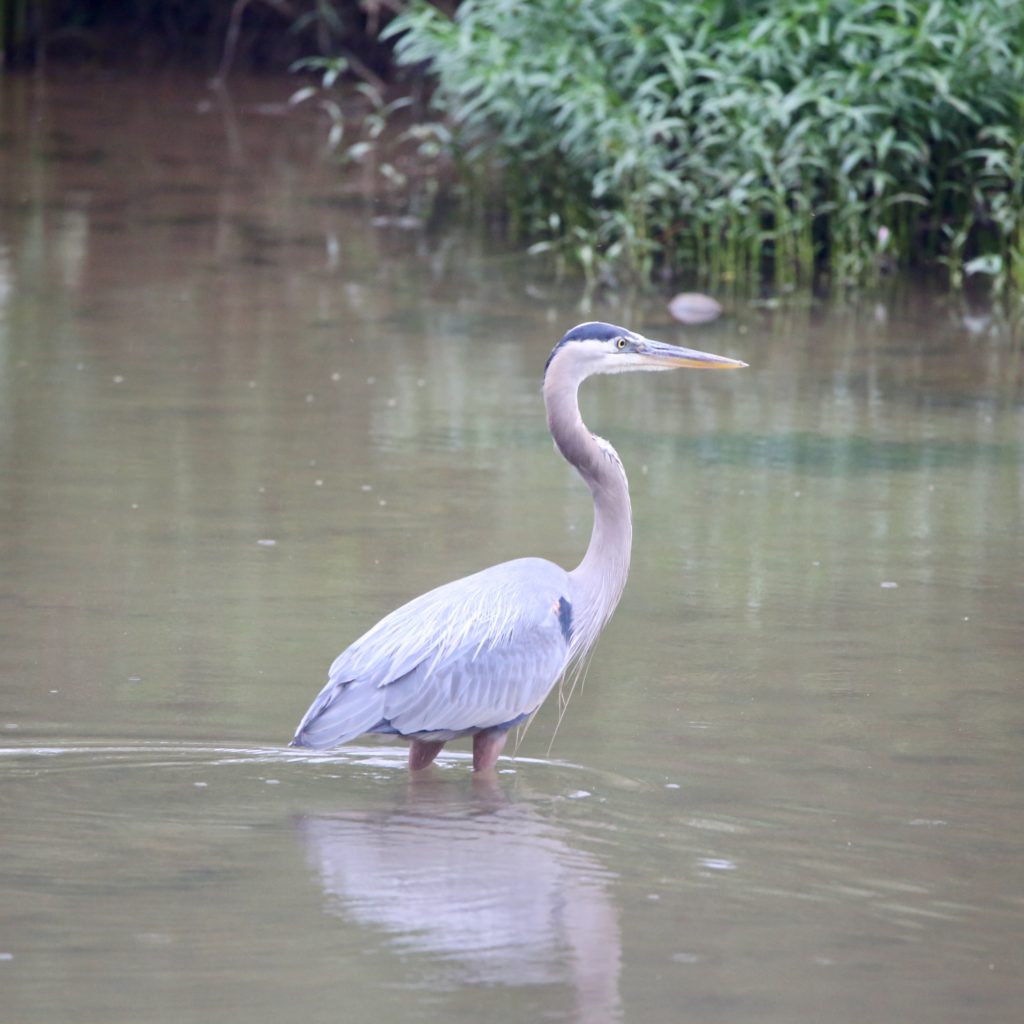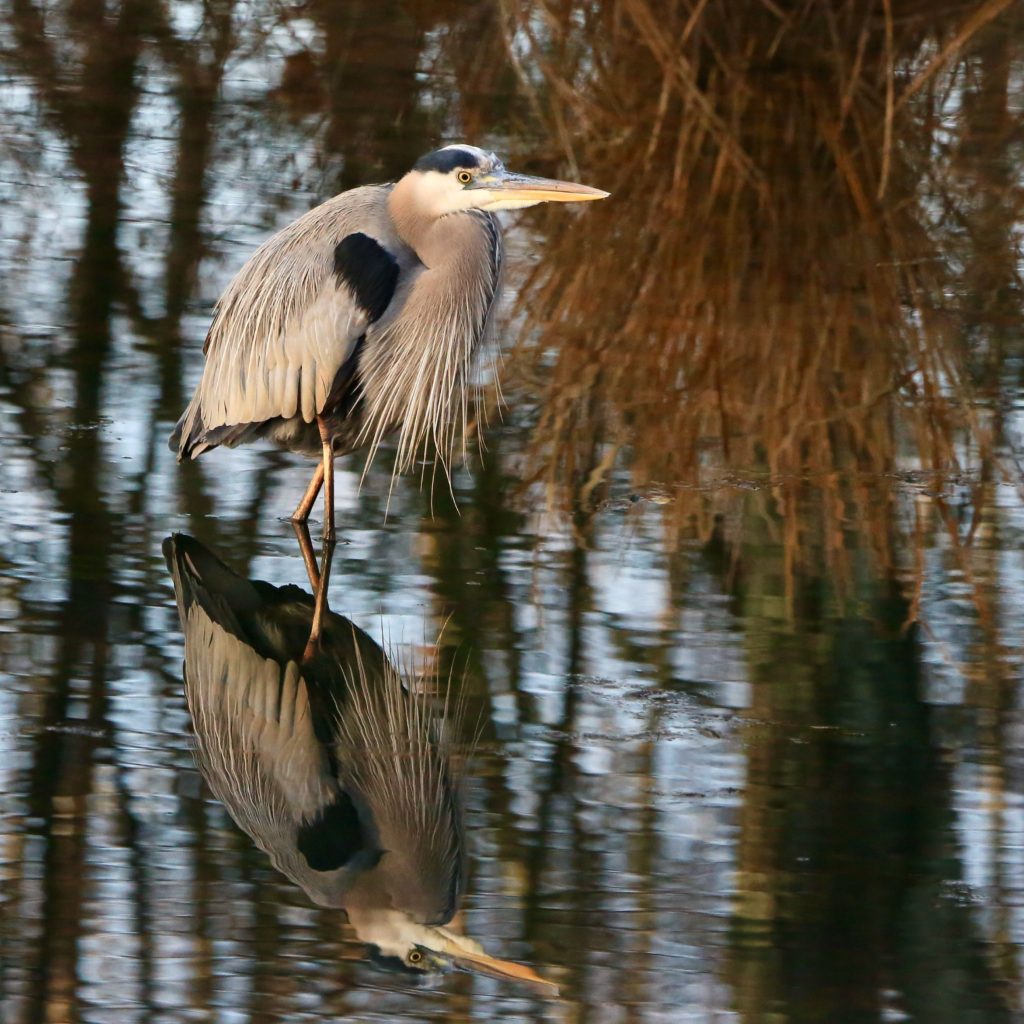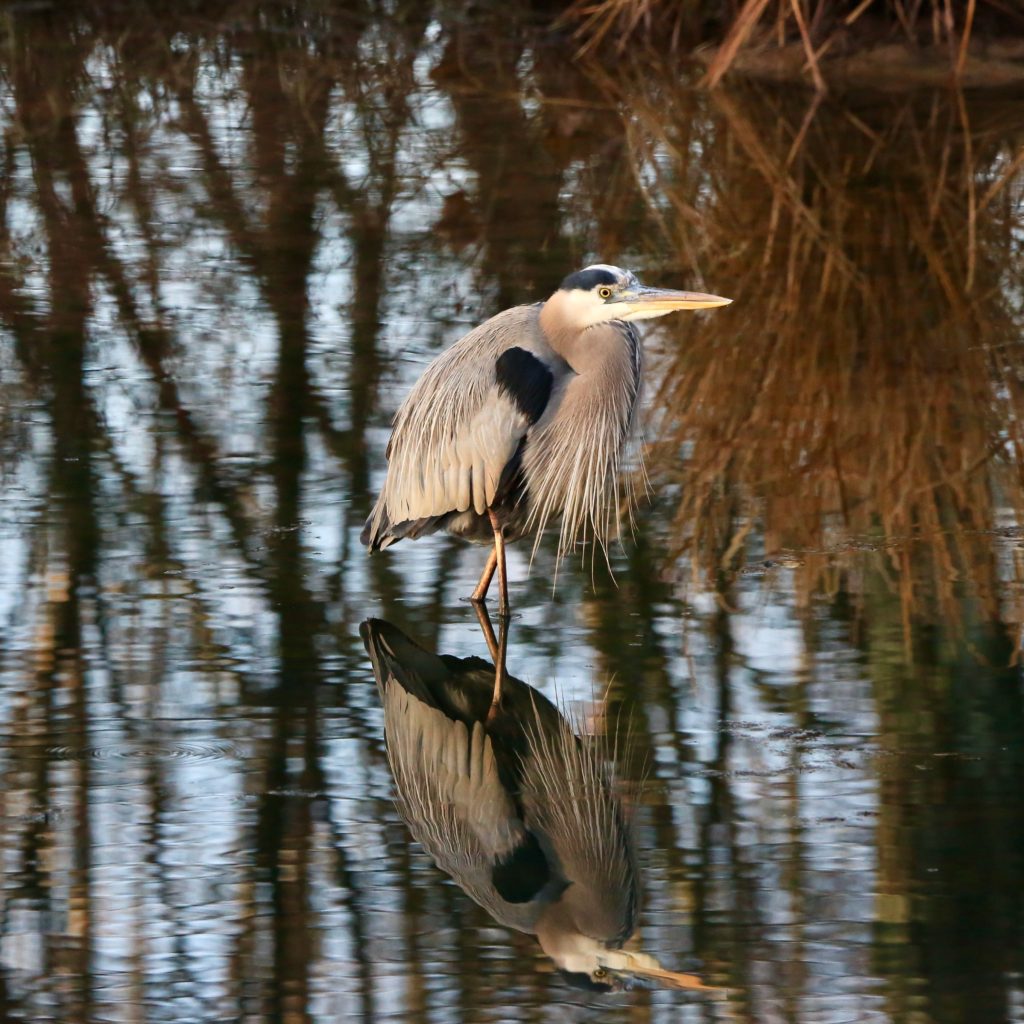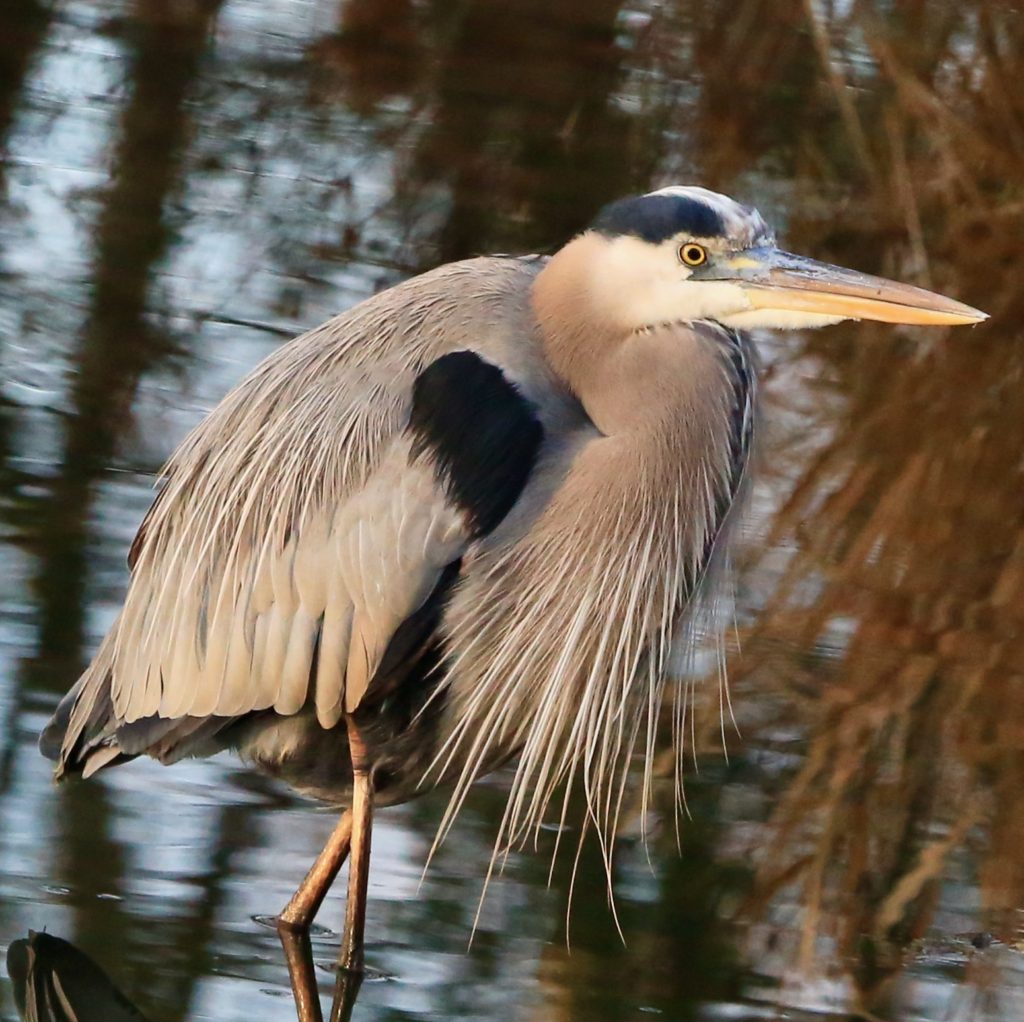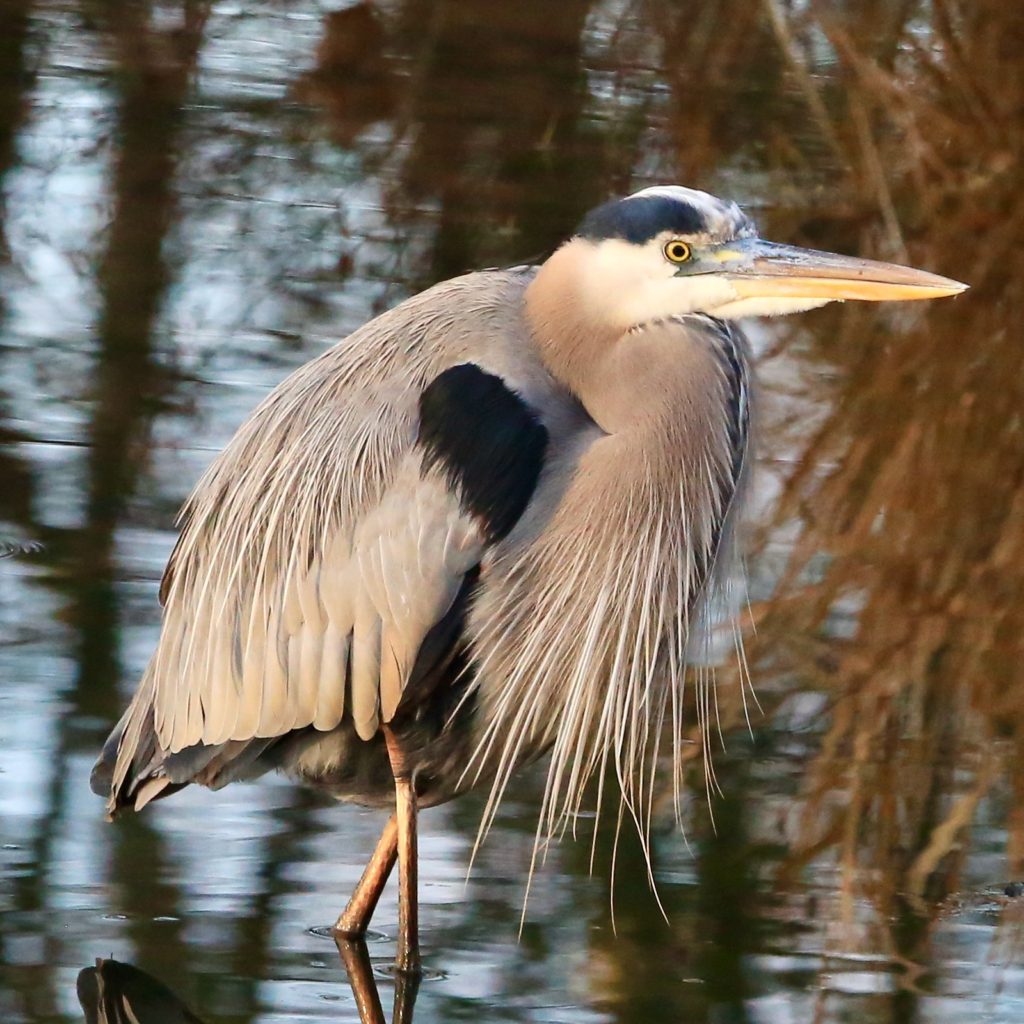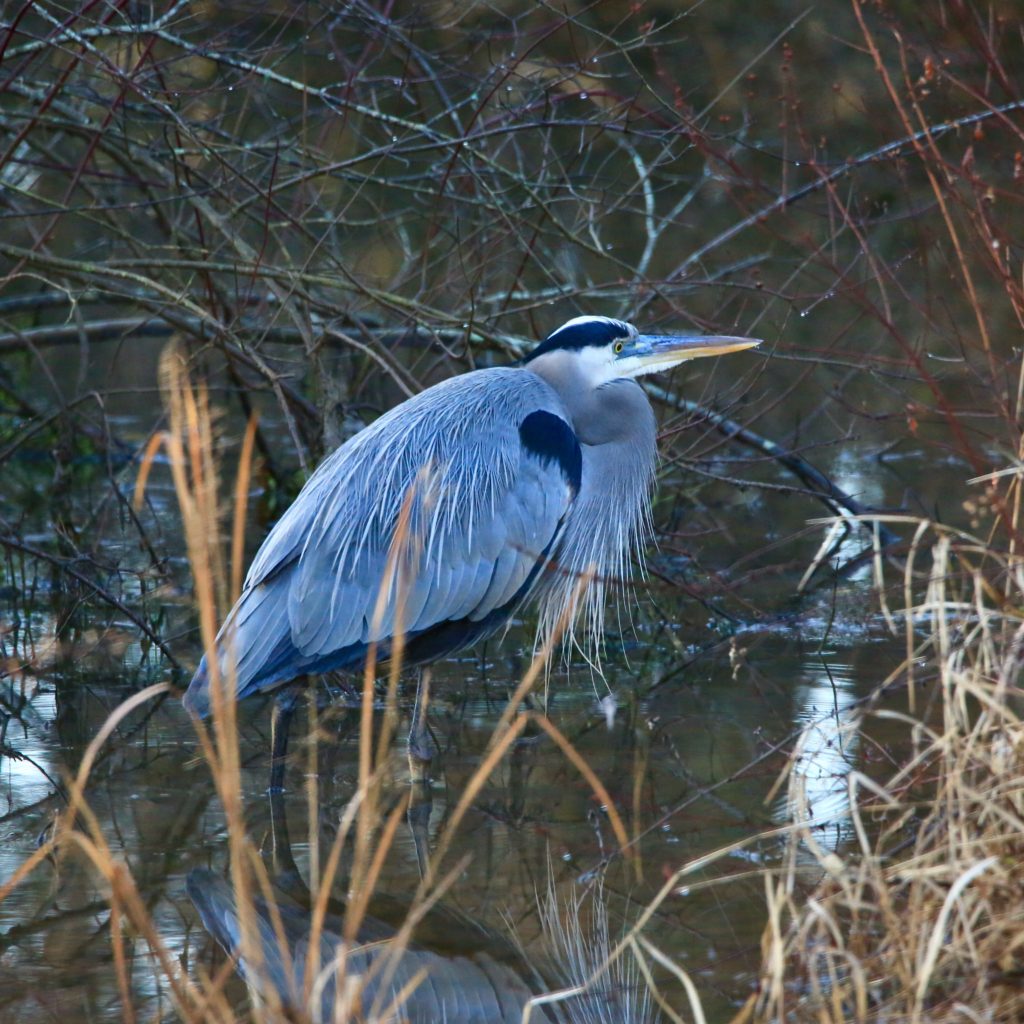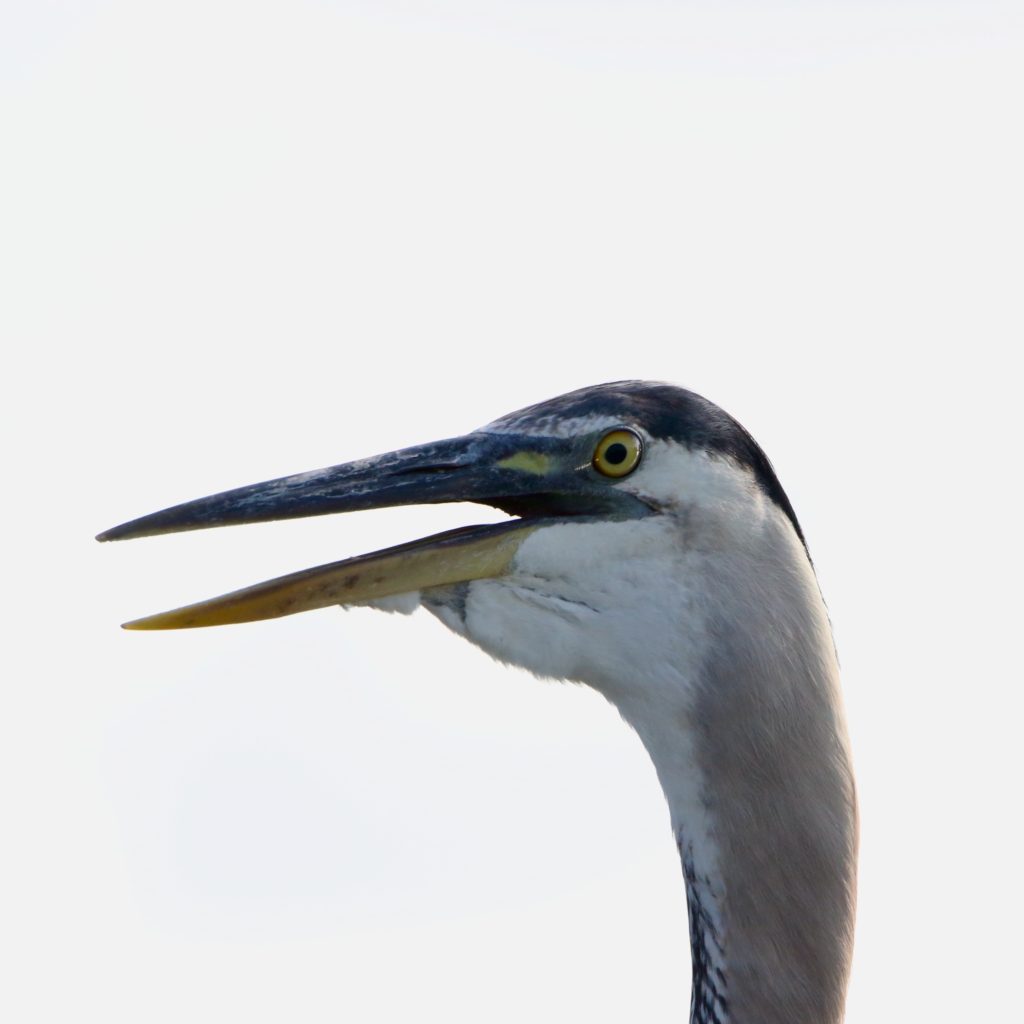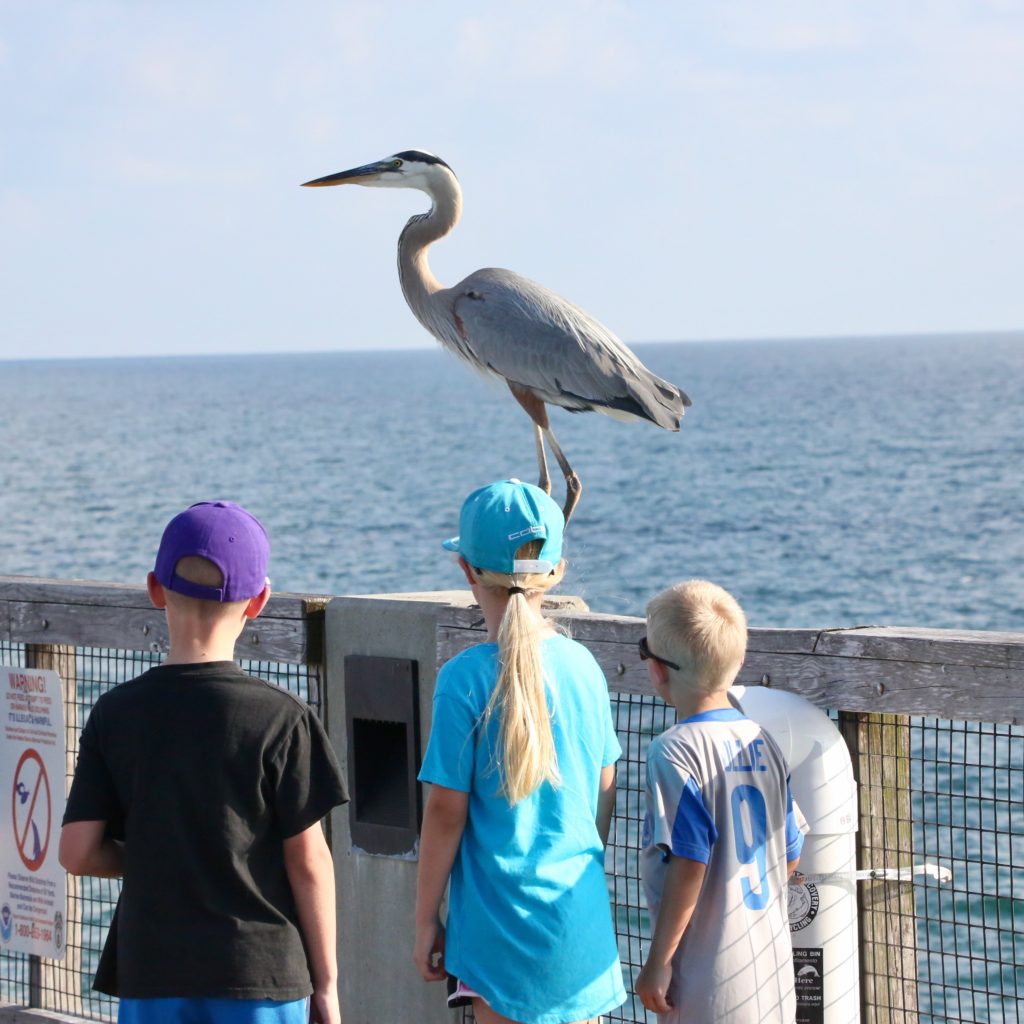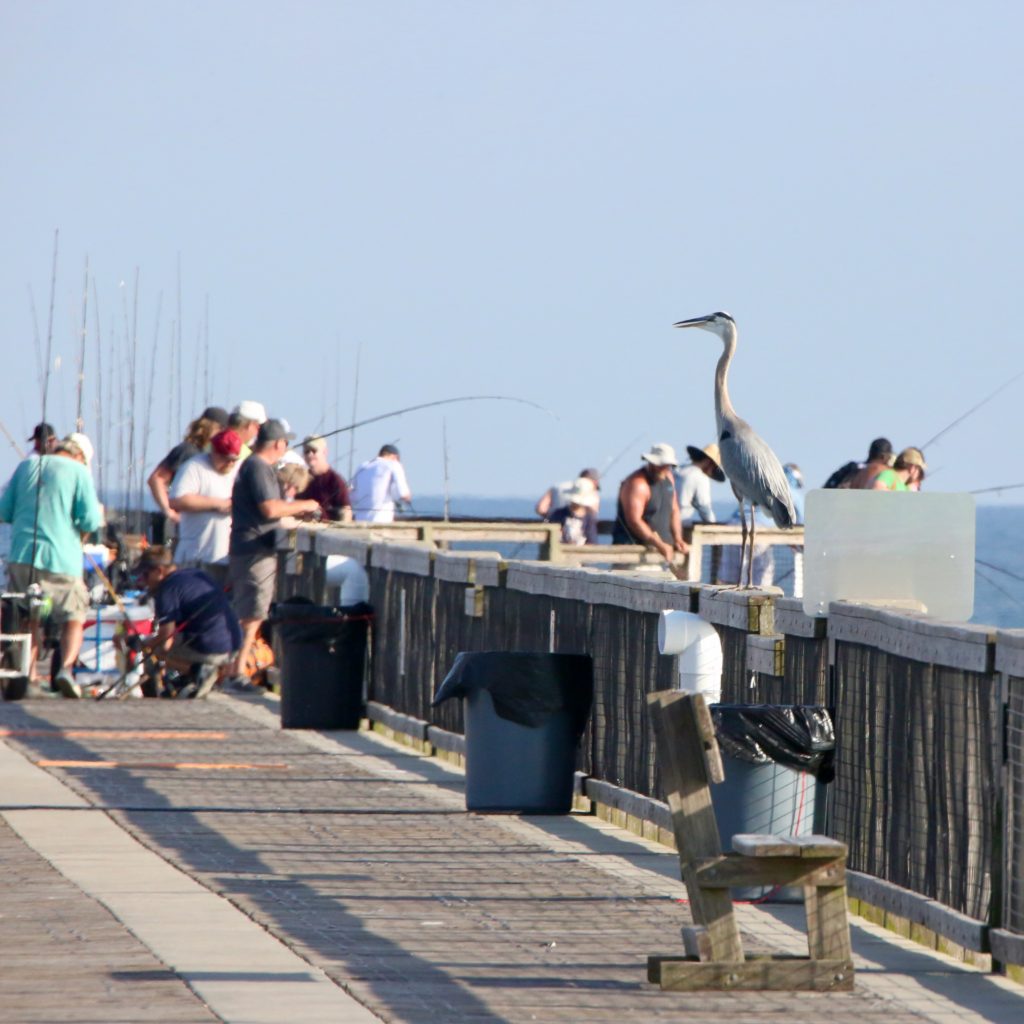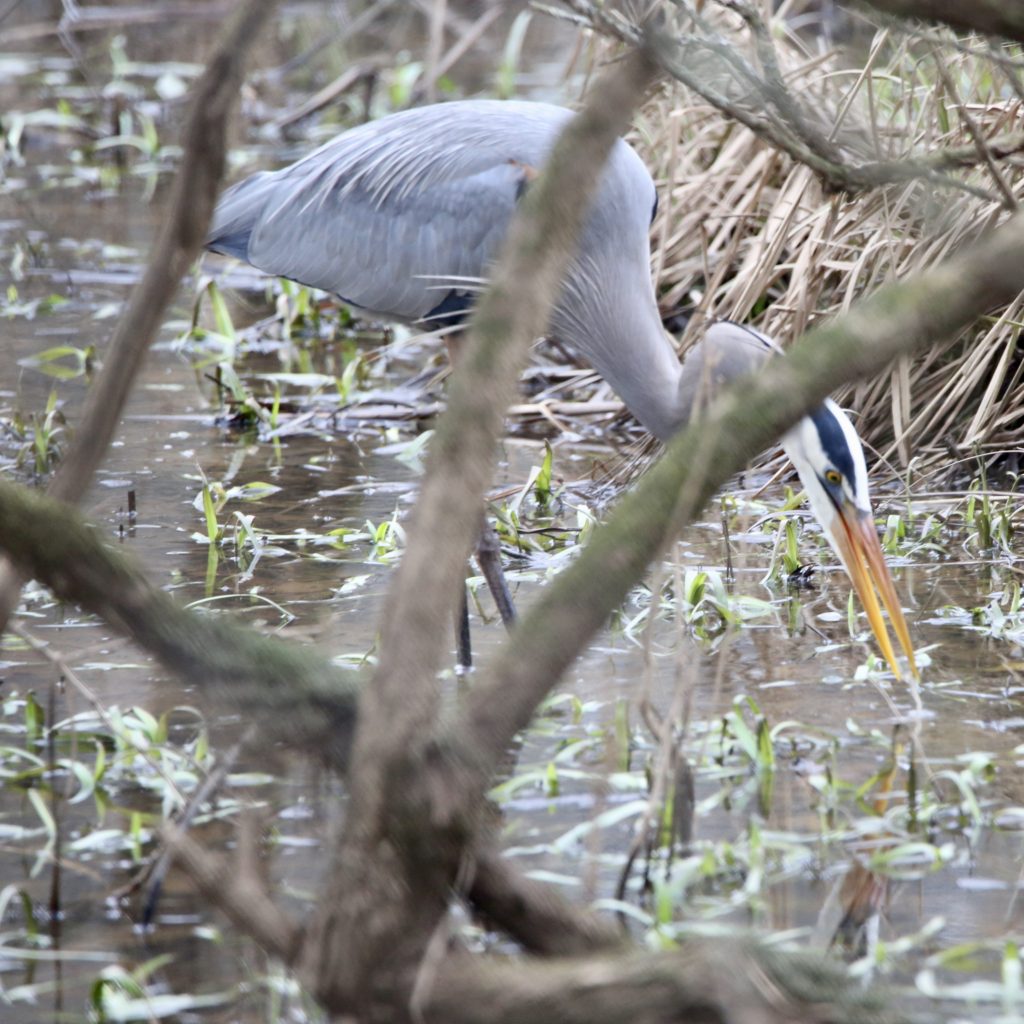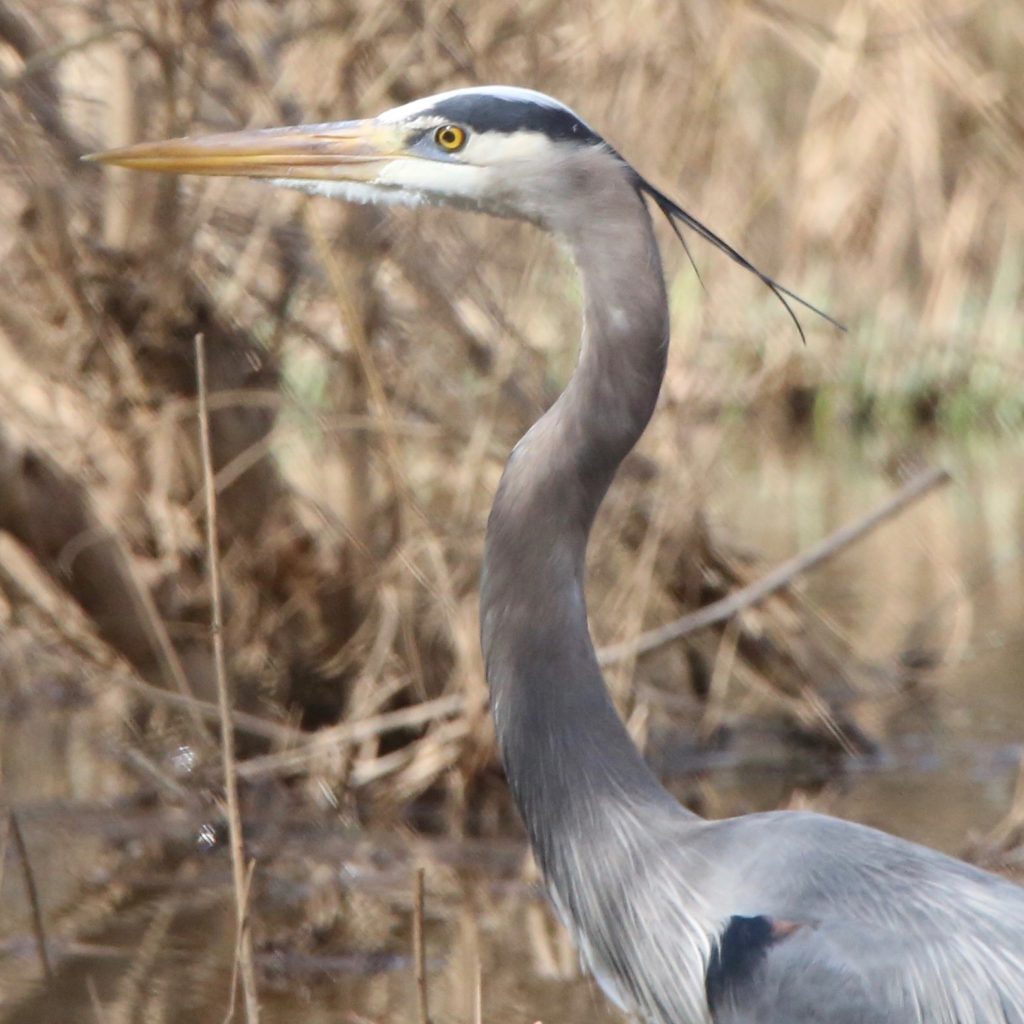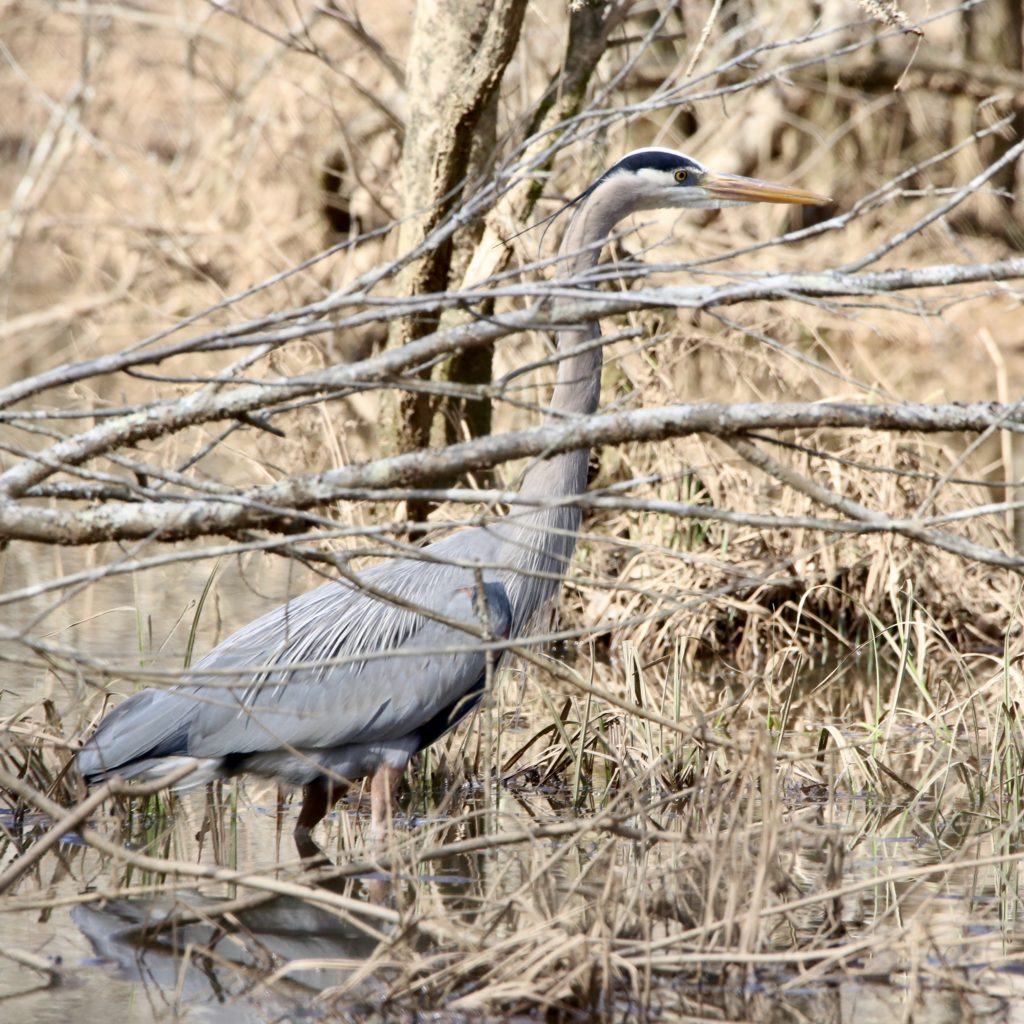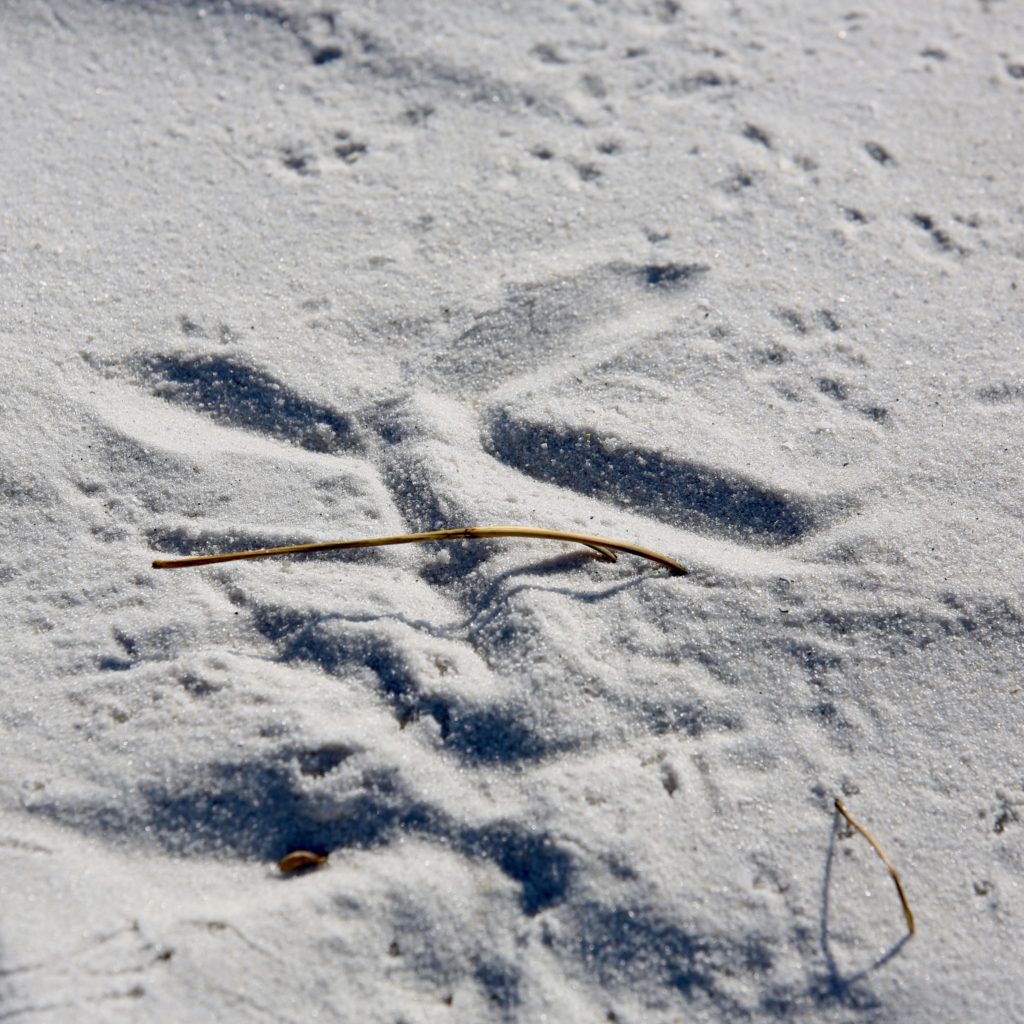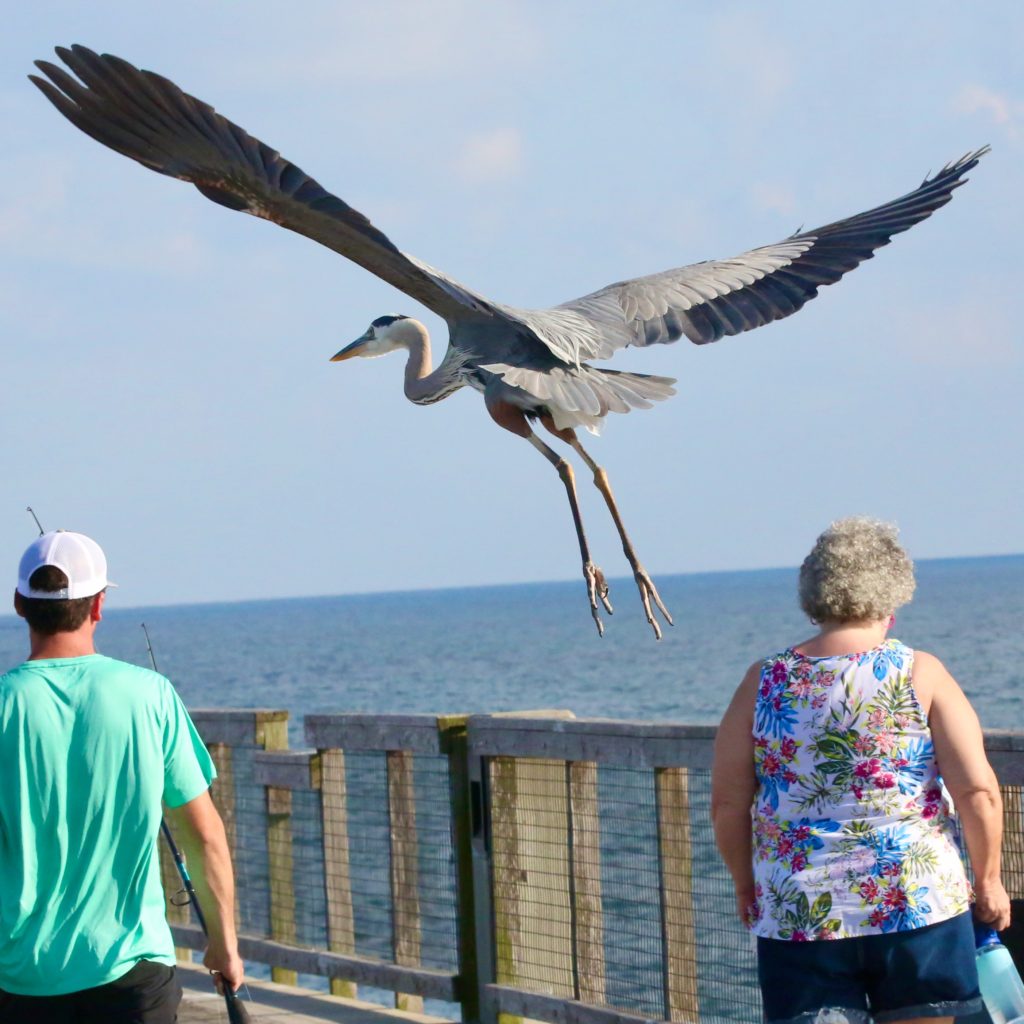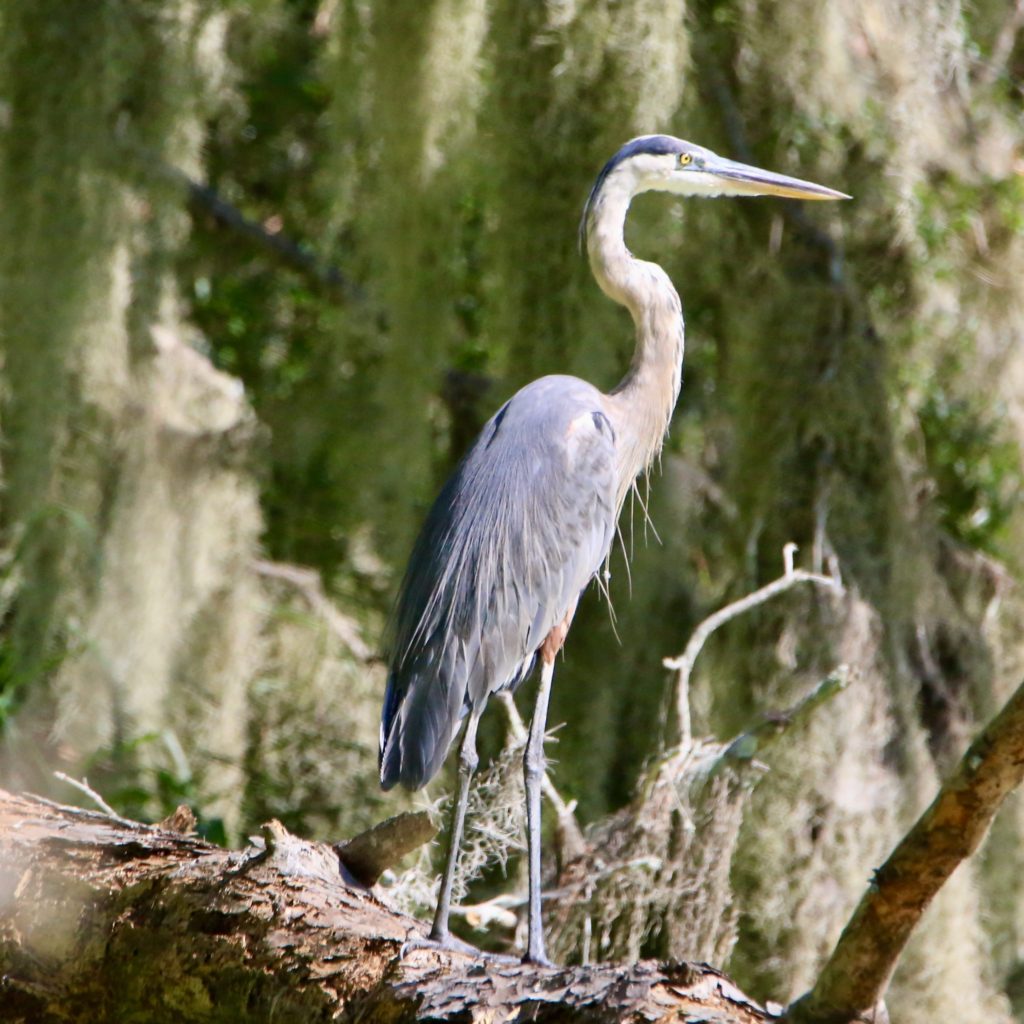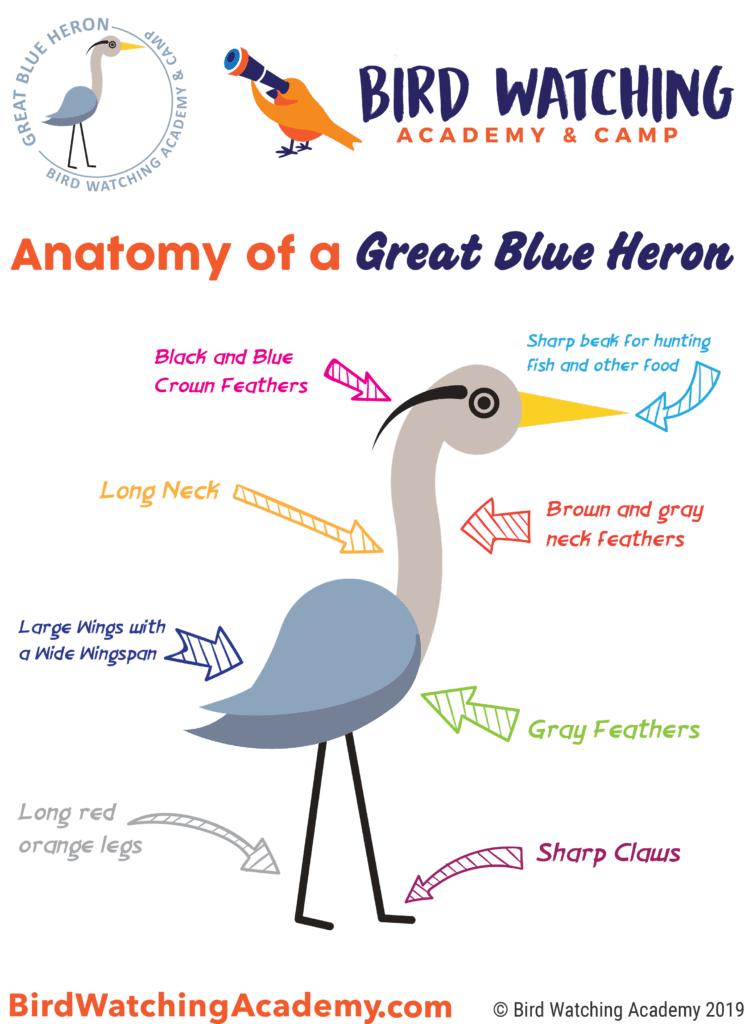
Great Blue Heron
A Great Blue Heron is a fun bird to see while bird watching. Below are some tips to help you identify Great Blue Herons. We have also put together a list of fun Great Blue Heron t-shirts, Great Blue Heron bird patches, bird houses, bird feeders, binoculars, stickers and other fun bird watching items.
About the Great Blue Heron
North America’s most widespread and largest heron is the Great Blue Heron (Ardea Herodias). The Great Blue Heron often called the “Crane” often stands quietly along rivers.
Great Blue Heron Color Pattern
Great Blue Herons have distinctive blue-grey plumage all over its body. Another distinct feature of its color pattern is a wide black stripe on its face that runs over its eye. When in flight, the upper side of its wing appears to be two-toned; slightly pale on the foreside of its wing and much darker on the flight feathers.
It has long legs with rusty-red thighs and a long, straight, dagger-like yellowish bill that turns orange at the beginning of the breeding season.
Description and Identification
Notable features of Great Blue Herons are slaty, gray with a slight azure blue. The herons have flight feathers, red-brown thighs, and a paired red-brown and black stripe up the flanks. The birds have a rusty-gray neck, with black and white streaking down the front, paler head, with a nearly white face, and a pair of black or slate plumes run from just above the eye to the back of the head. Their feathers are on the lower neck are long neck and their bill is dull-yellowish. The juveniles are duller in color, with a dull blackish-gray crown, and the flank pattern is only weakly defined. The younger ones have no plumes, and their bill is dull gray-yellow.
Great Blue Heron Size
As the largest heron in North America, the Great Blue Heron has long legs, a supple neck and a thick bill that resembles a dagger. Its wings are described as broad and rounded.
The relative size for both sexes is:
- Length: 38.2-53.9 in (97-137 cm)
- Weight: 74.1-88.2 oz (2100-2500 g)
- Wingspan: 65.8-79.1 in (167-201 cm)
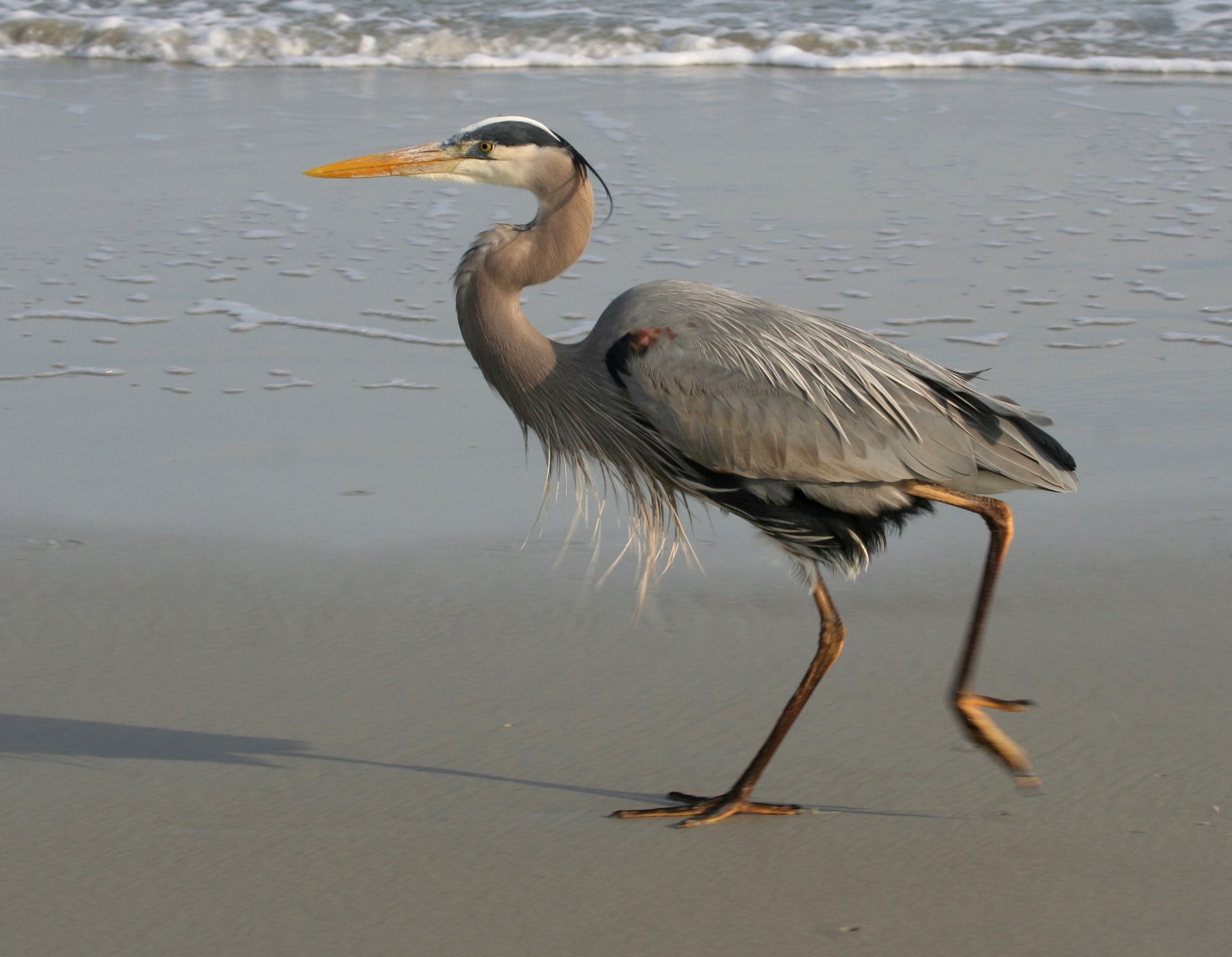
Great Blue Heron Behavior
- Although most tend to remain in the Northern parts of their range, their migration period begins in the fall.
- Generally, Great Blue Herons are slow stature-like birds that stay stalking fish in open shallow water. Even though their stance is slow and still, they have lightning-fast thrusts of their neck when fishing out their prey.
What Great Blue Heron Eat
The primary food for great blue herons is small fish. The birds can eat nearly anything within striking distance, including amphibians, reptiles, small mammals, insects, and other birds. They are known to opportunistically feed on a wide range of shrimp, crabs, rodents, aquatic insects, and other small mammals. The herons grab smaller prey in their strong mandibles or use their dagger-like bills to impale larger fish. They often shake them to break or relax the sharp spines before gulping them down. Great Blue Herons have been spotted stalking voles and gophers in fields.
Although they are primarily fish eaters, they also eat insects and frogs. They hunt for their food by both day and night.
Where Great Blue Herons Live and Their Habitat
Great Blue Herons are very adaptable; they can adapt to almost any wetland habitat in their range. You can spot these birds in fresh and saltwater marshes, mangrove swamps, flooded meadows, lake edges, shorelines, and tide flats. The herons rarely venture far from water bodies; however, they are occasionally seen flying over upland areas. They also forage in grasslands and agricultural fields. The birds usually nest in trees or bushes near the water’s edge, often on islands or partially isolated spots.
The Great Blue Heron can be found along the shores of lakes and in the wetlands from Alaska, Canada and all the way to the Caribbean.
Range and Migration

Great Blue Herons are large wading birds in the heron family of Ardeidae. They are common near the shores of open water and in wetlands over most of North America and Central America. These herons are also found in the Caribbean and Galápagos Islands. They are a rare vagrant to coastal Spain, the Azores, and areas of far southern Europe. Great Blue Herons are partial migrants; they move away from the northern range of their breeding range in winter, others fly as far south as the Caribbean. They migrate by day or night, maybe alone or in flocks.
Nesting
Great Blue Herons mainly nest in trees and on the ground, on bushes, in mangroves, and on structures such as channel markers, duck blinds, or artificial nest platforms. Male herons collect much of the nesting material and present them to females. Ground-nesting herons use vegetation such as salt grass to form the nest. The herons breed in colonies, in trees close to lakes or other wetlands. Adult herons usually return to the colony site after winter from December to March. Eggs are usually laid at two-day intervals and incubated for around 27 days. Male herons incubate for about 10.5 hours of each day, while female herons incubate for the remainder of each day and the night.
Great Blue Heron Lifecycle
The female Great Blue Heron lays three to seven pale blue eggs. They nest their eggs in twigs softly line with soft material for incubation. Incubation is done by both the male and female bird in the course of 25 to 30 days. The young chicks are fed by means of regurgitation and are ready to leave the nest after 65-90 days.
Anatomy of a Great Blue Heron
Kids learning about anatomy of birds is a great way to help them become better bird watchers.
Anatomy is the study of animals or other organisms and their parts. Bird Anatomy is the study of bird and their parts. Birds have beaks, wings, talons, feathers, and other parts that are important to learn about. Learning about bird anatomy will also help kids learn how to identify birds. We focus on the exterior, external, or outside anatomy of birds to help kids learn how to identify them.
Some other types of bird anatomy are the skeletal system, muscular system, circulatory system, respiratory systems, and digestive systems. Birds also have reproductive systems, nervous systems and immune systems. Birds are amazing creatures.
FREE PRINTABLE BIRD ANATOMY INFOGRAPHIC
Here is a fun printable design to help kids learn about the Great Blue Heron.
CLICK HERE TO DOWNLOAD AND PRINT THIS FILE Bird Anatomy Great Blue Heron
Below is a blank copy to test your kids on the bird anatomy of a Great Blue Heron.
CLICK HERE TO DOWNLOAD AND PRINT THIS FILE Bird Anatomy Great Blue Heron Test
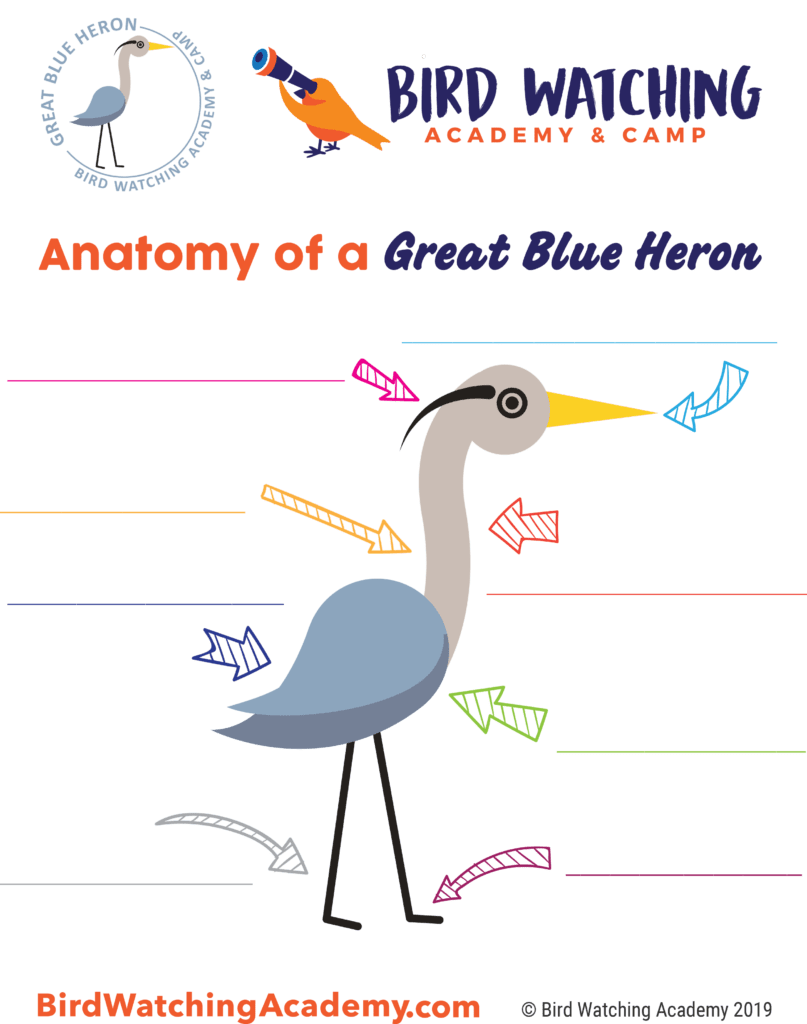
Ornithology
Bird Watching Academy & Camp Subscription Boxes
At Bird Watching Academy & Camp we help kids, youth, and adults get excited and involved in bird watching. We have several monthly subscription boxes that you can subscribe to. Our monthly subscription boxes help kids, youth, and adults learn about birds, bird watching, and bird conservation.
Bird Watching Binoculars for Identifying Great Blue Herons
The most common types of bird watching binoculars for viewing Great Blue Herons are 8×21 binoculars and 10×42 binoculars. Bird Watching Academy & Camp sells really nice 8×21 binoculars and 10×42 binoculars. You can view and purchase them here.
Great Blue Heron T-shirts
If you love the Great Blue Heron you should purchase a Bird Watching Academy & Camp T-shirt. To help support bird conservation we donate 10 percent to bird conservation activities.
Great Blue Heron Iron On Patches
Kids, Youth, and Adults love to collect our Bird Watching Academy & Camp iron on patches. Our bird watching patches help you keep track of the birds you have seen an identified. You can also display the patches on our Bird Watching Academy & Camp banners.
The Great Blue Heron is a great iron on patch to start your collection with. The patches are durable and can be sewn on or ironed on to just about anything.
Great Blue Heron Stickers
Stickers are a great way for you to display your love for bird watching and the Great Blue Heron. We sell a monthly subscription sticker pack. The sticker packs have 12 bird stickers. These sticker packs will help your kids learn new birds every month.
Bird Feeders For Great Blue Heron
There are many types of bird feeders. Here are our favorite bird feeders for your backyard. We use all of these bird feeders currently. Kids will have a great time watching birds eat at these bird feeders. Using this collection of bird feeders will provide a wide variety and many types of birds.
Best Bird Houses for Great Blue Heron
There are many types of bird houses. Building a bird house is always fun but can be frustrating. These 4 bird houses have become our favorites. Getting a bird house for kids to watch birds grow is always fun. We spent a little extra money on these bird houses but they have been worth the higher price and look great.


